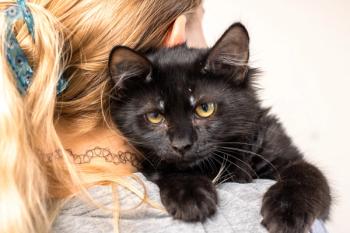
- April 2018
- Volume 3
- Issue 3
Recognizing and Reporting Abuse and Neglect
Veterinarians are in a prime position to identify and address animal mistreatment. Here’s what you need to know.
When you became a veterinarian, you pledged an oath to use your “scientific knowledge and skills for the benefit of society through the protection of animal health and welfare, [and] the prevention and relief of animal suffering...”
Normally, carrying out that promise and caring for your patients is fairly straightforward, but on occasion you might see a case that doesn’t sit well with you. Maybe the abuse is obvious, but more often than not, you just have a feeling that this animal’s suffering has been caused by the hand of a person. Whether the situation is one of ignorance, neglect, or outright cruelty, turning your suspicion into action requires a careful approach.
RELATED:
- AVMA 2017: How to Deal With Animal Neglect Cases
- Veterinarians: Protecting Pets and People from Abuse
It is a misconception that animal abusers do not seek veterinary care for their pets, so chances are you will see a neglected or abused animal at some point in your career. In a survey of veterinarians, 87% reported having treated abused patients and 60% reported treating an animal they suspected of being severely or intentionally abused.1 Thus, it is important to have a plan in place to which the entire practice can refer when this inevitability happens. This policy should identify which agencies need to be informed, what client and patient information should be conveyed, and how to collect and preserve evidence.
What Does the Law Say?
Although your oath obligates you to recognize and report suspected abuse, you are not responsible for proving that the abuse or neglect occurred. That is the job of the local agency tasked with investigating and prosecuting these cases. However, you should understand and teach your staff how to collect, document, and preserve evidence properly.
Gathering Evidence
Perhaps the most important aspect of these cases is keeping meticulous records to maintain the chain of
First collect the evidence that is most likely to be destroyed or degraded by time, environmental conditions, or deliberate action. To prevent tainting it, wear gloves, a cap, a mask, or other gear as appropriate. It’s wise to keep a digital camera handy; most of today’s equipment also takes video.
Besides noting obvious injuries, examine the pet’s coat, mouth, and paws for evidence of chemicals, fiber, or other materials that may indicate home remedies. If an animal is at the clinic for a fracture and you suspect abuse, it may be worthwhile to take whole-body radiographs to look for previous fractures. Necropsy should be performed on any deceased animals. Note: You should establish ahead of time whether any extra steps you take to collect evidence—eg, additional diagnostic testing, blood work, or radiographs—are reimbursable by the agency pursuing the case.
What If You're Wrong?
Because you must often trust your instincts when
In all cases, it is important that you remain safe. Someone who readily abuses his or her pet may not be psychologically stable. Also, don’t break the law to help an animal—don’t trespass to check on a skinny horse, for example.
Another concern is what happens if you’re wrong: Can the person sue you? The short answer is yes, but many states provide
Conclusion
Society has evolved such that animals are now considered family members more than just pets or beasts of burden. However, they are not always treated as well as they should be. As a significant point of contact and someone who has the knowledge and training to recognize abuse and neglect, you can be a champion for the animals in your care. Unfortunately, handling such cases requires not only clinical expertise but also a variety of out-of-the-norm proficiencies, such as tact when broaching the subject with clients and strong documentation skills, not to mention a little bravery for putting yourself out there.
Thankfully, society also has evolved to recognize that neglect and abuse of animals can be criminal, and authorities and resources are available to assist you. By not turning your back on suspected animal abuse, cruelty, or neglect, you not only help the animal in front of you but also make society as a whole more humane.
Ms. Rogers has a bachelor of science degree in animal health from the University of Connecticut and a master of science degree in microbiology and molecular genetics from Rutgers University. She has more than 19 years of experience creating content for a variety of health care audiences. She lives in Kingston, New Jersey, and shares her life with a horse, a dog, and a cat.
References:
- Landau RE. A survey of teaching and implementation: the veterinarian's role in recognizing and reporting abuse. JAVMA. 1999;215(3):328-331.
- Walton-Moss BJ, Manganello J, Frye V, Campbell JC. Risk factors for intimate partner violence and associated injury among urban women. J Commun Health. 2005;30(5):377-389.
- Degenhardt B. Statistical Summary of Offenders Charged with Crimes against Companion Animals July 2001-July 2004. Chicago, IL: Chicago Police Department; 2005.
- Yoffe-Sharp BL, Loar LM. The veterinarian's responsibility to recognize and report animal abuse. JAVMA. 2009;234(6):732-737.
Articles in this issue
over 7 years ago
WRNC 2018: Managing Wounds in Wildlifeover 7 years ago
AVMA 2017: Protecting Backyard Poultry Owners Against Zoonosesover 7 years ago
Pets, Vets, and Opioidsover 7 years ago
WVC 2018: Global Guidelines Put Dental Health in the Spotlightover 7 years ago
NY Vet 2018: Evaluating and Addressing Feline Aggressionover 7 years ago
Student Team Wins Award for One Health Effortsover 7 years ago
Product Spotlight (April 2018)over 7 years ago
Heartworm: Where Are We Today?over 7 years ago
What Is A Veterinarian?Newsletter
From exam room tips to practice management insights, get trusted veterinary news delivered straight to your inbox—subscribe to dvm360.






